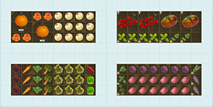You must first log in or sign up before accessing this page.
Legend
- Start Indoors
- Transplant
- Start Outdoors
- Care
- Harvest
- Succession Plant
Sunflower : American Persimmon

Large Fruiting Tree
The American Persimmon (Diospyros virginiana) is native to the eastern United States and is higher in nutrients like vitamin C, calcium, iron and potassium than the Japanese Persimmon. Its fruit is traditionally eaten in a special steamed pudding in the Midwest and sometimes its timber is used as a substitute for ebony. Persimmons are deer candy. If you have any persimmon trees where you hunt, you know that the deer seek out these small, delicious fruit. The scientific name for the persimmon is Diospyros, or "fruit of the gods". For humans, the American Persimmon has alum in the skin, which disappears when the fruit ripens, usually after the first frost. If you have eaten a persimmon before it was ripe, you know it will suck the wax back out of your ears. But after it ripens, it has a rich, sweet, almost nutty flavor. Luckily, this does not bother deer or game, which will eat persimmons right off the tree, or when they have fallen on the ground.
Persimmons are easy to grow, and will bear in just a few years. The native persimmon trees are either male or female (and you can't tell looking at them), and so you should plant several together to make sure that you will get at least one female that will bear fruit.
Asteraceae Helianthus annuus
This is an example of the timeline you would see based on your growing conditions.
Sunflower: Giant
American Persimmon
These beautiful exuberant plants can reach 12' in height or more and produce flowers a foot across.
Basics
- Ease of Growing
- Easy
- Grown as
- Annual
- Days to Maturity
- 90-100 (Fall/Winter)
- Growing Habit
- -
- Hardiness
- Half Hardy
Sunflowers will tolerate light frost.
- Crops
- Spring Transplant, Spring, Summer
- Growing Season
- Long
- Cultivar Type
- -
- Growing Conditions
- Warm, Hot
Sunflowers needs rich soil for good growth. They prefer full sun (though they will tolerate light shade). The taller varieties need shelter from the wind and should be placed where they won't cast unwanted shade on other plants.
- Outdoor Growing Temp
- 55°F - 95°F
- Min Outdoor Soil Temp
- 50°F
Don't plant out until the soil is at least 50˚ F (and preferably 60˚ F).
- Start Indoors
- Yes
- Start Outdoors
- Yes
- Light
- Water
- Moderate
Sunflowers are thirsty plants and for maximum production they need a constant supply of water.
- Feeder
- Heavy
Low nitrogen. High phosphorus. High potassium. Sunflowers like phosphorus and potassium, but not too much nitrogen as it may encourage leaf growth rather than flowering.
- Suitability
- High heat, Needs lots of space
- Small Gardens?
- No
- Containers?
- No
-
- Attracts beneficial insects?
- Yes
- Color
- Golden
- Fruit Size
- 10.0 - 18.0"
- Plant Height
- 144.0 - 168.0"
- Plant Diameter
- 12.0 - 18.0"
- Good Companions
- Melon, Cucumber
- Bad Companions
- Bean
- Hardiness Zone
- 3-10
- Disease Resistance
- -
- Taste Profile
- -
- Rotation Group
- Flowers
Last Frost Date (LFD) refers to the approximate date of the last killing frost of spring.
Example first frost date on April 08.
First Frost Date (FFD) refers to the approximate date of the first killing frost of winter.
Example first frost date on November 01.
Current week.

